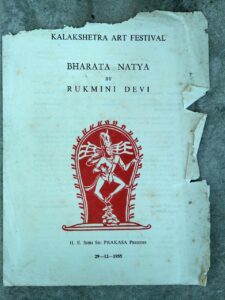Team L&M
Mohan Khokar Dance Collection presents Rukmini Devi as 5th episode, in ongoing virtual dance series by Habitat World. She institutionalised Bharatanatyam by creating an institution in 1936 called Kalakshetra, where Mohan Khokar was the first male student from North India, in1945. He reached Madras (now Chennai) from undivided Punjab by changing five trains over ten days.

Some memorabilia of the times gone by
Rukmini Devi married theosophist George Arundale and together they created Kalakshetra in the outskirts of Madras (now Chennai). She had learnt Bharatanatyam from vidwan gurus Muthukumaran Pillai of Kattumunar koil , Chidambaram and Meenakshi Sundaram Pillai of Pandanallur. She realised how important it was to give a wholesome and systematic training in the form. So, Kalakshetra happened.
Mohan Khokar saw Uday Shankar and Ram Gopal perform in the then cultural capital of north India, Lahore, and fell in love with dance, especially Bharatanatyam. When he asked where to learn , most said MADRAS (now Chennai), as if it was nearby or one place! It was a Presidency in the then British India, comprising parts of Andhra and Karnataka. Mohan Khokar, son of a Defence Commissioner, whose family had nothing to do with any art, left home and arrived at Madras in 1944. He asked where to learn dance. Many said: there’s a lady with white hair, sitting under a big tree, who teaches. He searched and searched and in the outskirts of Madras (now Chennai) did find a lady, sitting under a Banyan tree, teaching Bharatanatyam! Rukmini Devi Arundale. Seeing the boy from Punjab, she thought he had run away from home and asked him “why you have come all the way?” When she got to know of his undying love for dance, she adopted him as her “son”. Till end he remained devoted to her. Many years later Mohan had a son, born the same day as his guru was on the February 29, a leap year day! Ashish Khokar. The younger Khokar too helped institutionalise dance by saving his father’s lifetime work, the MKDC or Mohan Khokar Dance Collection.
The MKDC contains rare documents, brochures and letters plus posters, artefacts and memorabilia. Mohan Khokar started collecting dance things in Madras (now Chennai) in 1945. Britishers were leaving India and selling off their books and things as raddi (junk) and Khokar had the foresight to grab all he could. A great visionary that he was he often didn’t have enough money, and at times like these he would forego food to buy a book or an art work.
Ashish Khokar has authored more than 40 art books on varied subjects
It’s that vision that informs the MKDC which now is 150 trunks and boxes of Indian dance history and heritage, donated in toto to the IGNCA by son and successor Ashish Khokar, himself a critic of note, author of repute and historian of merit. Ashish Khokar sacrificed an international career in arts administration , where he was highly successful (10 times USA with exhibitions and events; 20 trips to Europe for lectures in universities, including handling huge festivals of India of government cultural exchange programmes in Sweden, France, Germany and later, China) to serve Indian dance. Today, his work of 50 years, bears fruit through 45 books he has written and 85 dance modules made for UGC e-pathshala. Between the two Khokars , a 100 years of dance history is saved and served. Have they even got a Padma award? No, in India, often honest work goes unseen or unrewarded. Even in dance, politics prevail. But Khokars continue with mission impossible!
Watch on Habitat World. All of October, four films: Tracing Dance (October 5 ), Rukmini Devi (October 12), Bala (October 19 ) and the last one, Choreography Today (October 26).